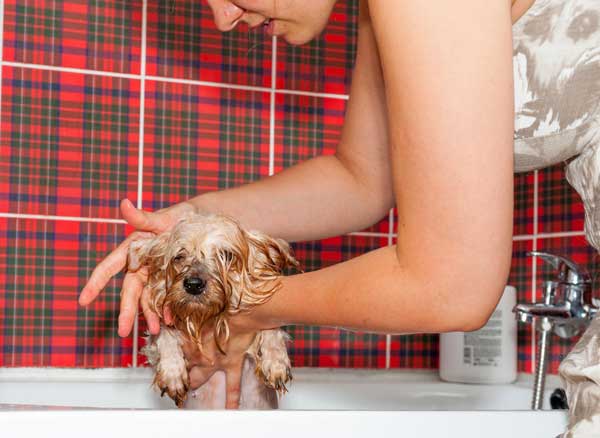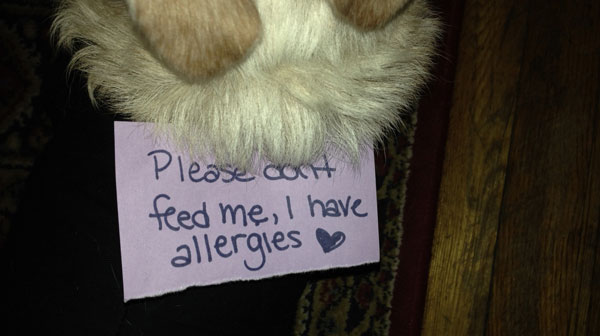Watching your dog scratch and lick herself throughout spring and summer can be heartbreaking. Unfortunately, there may be no cure for some allergies in dogs. The best we can hope for is that a combination of therapies may give them some relief and reduce the incidence of secondary infections and visits to the vet. The following ideas are some of the things that have helped many of my clients over the years and my own itchy dog. I hope that in passing them on I can give your pet some relief.

Puppy scratching by Shutterstock.
A brief rundown on allergies in dogs
Before we get onto the tips, here’s a rundown on what is going on with allergies and the main causes. An allergy is basically an overreaction by the immune system to something normal in the environment. Allergies usually develop in dogs more than year of age and can be hereditary. Allergies in dogs lead to foot-licking, scratching, ear infections, hair loss, anal gland problems as well as visibly inflamed skin, often with secondary infections.
Here are the main causes of allergies in dogs:
- Fleas. One flea bite can keep an allergic dog itching for two weeks! This is the most common allergy, and usually starts around the base of the tail.
- Food. Any protein can lead to an allergy. Food allergies account for around seven percent of allergies in dogs, and you may need an elimination diet to diagnose them.
- Contact allergies. These usually involve plants or grasses and mainly lead to irritation on the feet or hairless areas on the underside of the abdomen.
- Atopy. This is usually seasonal and caused by a variety of airborne allergens. Atopy can be likened to hay fever in humans, but in dogs atopy causes itchy skin.
What causes seasonal itching?
Atopy and contact allergies are usually involved in seasonal itch. Dust mites, pollens, grasses, or any number of airborne allergens in the environment are the usual culprits. When atopic dogs are tested either by a blood test or skin patch testing, they are tested for up to 83 different allergens — another reason why the solution is not necessarily simple. Many dogs have multiple allergies, rather than just one.

Itch threshold
One of the more interesting allergy theories, this essentially means that the triggers for scratching in allergic pets can be cumulative. For those dogs who have multiple allergies (such as a food allergy and a grass allergy), control of even one of the triggers may be enough to keep them below the threshold where they become itchy. This is why a combination of therapies works very well and also why excellent flea control is incredibly important.
Even if fleas are not the primary cause of the allergy, use the fastest-acting flea product available (Comfortis) and good environmental flea control. It may also be worthwhile doing a food trial with one novel protein source and a carbohydrate for eight weeks (for example sweet potato and rabbit/kangaroo/venison).

Atopy and infection
Many of the therapies for allergic dogs focus on improving skin barrier function. Often dogs with allergies have dry, scurfy skin or greasy, smelly skin. Usually the cellular layers in the skin form nice tight junctions with a matrix of lipids and keratin to keep moisture in and bacteria and yeast out. Dogs with allergies have altered barrier function, allowing allergens to get through and leaving them prone to secondary infections. If your dog has inflamed, moist, smelly, ulcerated skin or has little scabby areas, see your vet for a course of antibiotics, as often the other strategies will not help until the infection is resolved. For very mild cases, shampoos containing chlorhexidine or miconazole can help with skin infections.

Tips and strategies for treating allergies in dogs
Try a combination of these things and hopefully your dog will get some relief:
- When your dog comes in from outside, use a damp towel to wipe him down, paying particular attention to the feet. Make sure the feet are completely dry afterwards.
- Use QV Bath Oil at the concentration on the bottle and allow your pet to soak in the tub for 10 minutes every three days.
- Use fatty acids, ideally with the correct ratio of omega-3 and omega-6 oils. You can also use fish oils or skin diets.
- Bathe your pet every three days or weekly with an oatmeal shampoo.
- If your dog gets itchy feet from walking on grass, pop on some boots.
- Wash any bedding, blankets, or soft toys weekly on a hot-washing cycle.
- Use HEPA filters in the home and either get rid of pillows or mattresses that can’t be washed or use dust-mite-resistant covers.
- If you have a garden, keep grasses short, particularly during periods of grass seeding or rapid growth.
- For moldy or damp houses, use dehumidifiers; don’t let your pet in the basement and avoid indoor plants.
- Use a topical steroid cream or spray for small areas such as feet.

Sometimes it is difficult to know what to do first with a newly diagnosed pet. If you haven’t already visited your vet, this is the most important first step. Make sure your flea control is up-to-date and perhaps take this list in with you to get some advice on which therapies to try first.
Also bear in mind the other options your vet can provide, such as allergy testing, immunotherapy, corticosteroids, and cyclosporine. My hope is that some of the strategies here may give your dog a little relief from his allergies and give you both a good night’s sleep.
Does your dog have allergies? What are you tips for combatting allergies in dogs? Tell us your tips in the comments!
Read more about allergies in dogs and flea control on Dogster:
- What Options Exist for Allergy Treatment in Diabetic Dogs?
- Is Your Flea Control Product Hurting Your Dog?
- 10 Tips for Keeping Your Home Flea-Free
- Why Are People Spending Thousands on Bogus Allergy Alert Dogs
- Ask a Vet: Can Dogs Be Allergic to Cats (and Vice Versa)?
- Dog Flea and Tick Treatment Options
Learn more about dogs with Dogster:
- 9 Tips for Keeping Your Dog Cool This Summer
- Let’s Talk: Does Your Dog Love to Roll in Stinky Things?
- Be Polite to Your Dog — It Benefits Both of You
About the author: With 7 years of small animal practice, Dr. Eloise Bright came to Love That Pet as animal lover and advocate for all animals from baby birds to stray kittens. With two sons in tow and hubby, Eloise mainly practices in Sydney, Australia. She has a dog, Duster, and a cat, Jimmy.
Puppy scratching by Shutterstock.
The post How to Combat Seasonal Allergies in Dogs appeared first on Dogster.
No comments:
Post a Comment